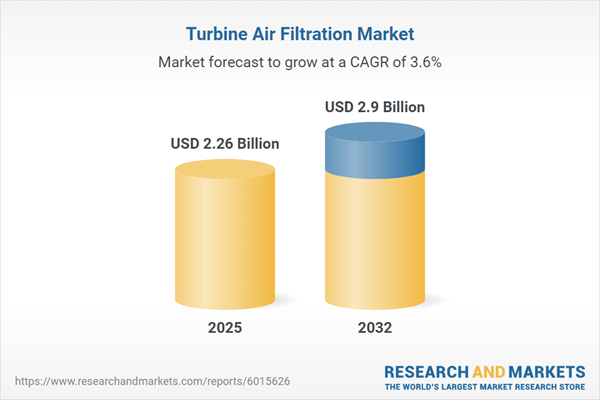Speak directly to the analyst to clarify any post sales queries you may have.
Amid shifting regulatory requirements, rising sustainability goals, and evolving supply chain pressures, senior leaders face complex choices in the turbine air filtration market. Organizations are looking for solutions that ensure consistent asset reliability, fulfill compliance mandates, and enable agile responses to changing operational demands.
Market Snapshot: Turbine Air Filtration Market Performance
The turbine air filtration market expanded from USD 2.18 billion in 2024 to USD 2.26 billion in 2025, moving ahead with a projected CAGR of 3.58%. Growth is propelled by sustained investment from the power generation and aviation sectors, where equipment uptime and lifecycle value directly influence operational outcomes. As organizations aim to limit maintenance disruptions and boost system performance, they increasingly invest in next-generation filtration technologies. These actions support broader aims of meeting sustainability objectives and demonstrating regulatory compliance, allowing companies to stay competitive and reduce exposure to evolving risks.
Turbine Air Filtration Market: Scope & Segmentation
This report traces a detailed framework of the turbine air filtration ecosystem, enabling targeted investment strategies and operational adaptability across diverse applications, filter types, and geographies. Segmentation provides critical insights for senior decision-makers:
- Applications: Coverage includes aviation turbines, gas turbines, industrial turbines, and steam turbines, catering to varying sectoral requirements and asset portfolios.
- Filter Types: Assesses bag filters, HEPA filters, panel filters, pleated filters, and ULPA filters, each suitable for specific technical standards and operational scenarios.
- Efficiency Ratings: Analysis of filtration options spanning MERV 8-11 to MERV 17-20, supporting system longevity, contamination management, and stricter compliance goals.
- Filter Materials: Reviews glass fiber, metal mesh, and synthetic fibers, connecting material selection to service life, budgetary requirements, and performance standards.
- End Use Industries: Provides profiles of marine, oil and gas, petrochemical, and power generation sectors, each presenting unique operational risks and performance thresholds.
- End Uses: Addresses solutions for new installations, retrofits, maintenance cycles, and asset overhaul strategies, reflecting diverse maintenance and lifecycle needs.
- Sales Channels: Outlines roles of OEM routes and aftermarket support networks, shaping procurement flexibility and supplier engagement.
- Regions: Identifies key geographic markets in the Americas, Europe, Middle East & Africa, and Asia-Pacific, each adjusting to distinct compliance drivers and market localizations.
- Leading Companies: Highlights major suppliers such as Donaldson Company, Camfil AB, MANN+HUMMEL GmbH, Parker-Hannifin Corporation, Filtration Group Corporation, Freudenberg SE, Danaher Corporation, Alfa Laval AB, Nederman Holding AB, and AAF International, focusing on their innovation footprints and service capabilities.
Key Takeaways for Senior Decision-Makers
- Advanced filter media such as nanofiber coatings and electrospun membranes support longer operational cycles and enhance predictive maintenance planning.
- Digital transformation through real-time monitoring and analytics drives improved asset reliability and allows maintenance teams to prevent costly unplanned outages.
- Changing global and local regulatory frameworks require ongoing investment in filtration solutions designed for environmental accountability and rapid compliance response.
- Regional manufacturing and nearshoring strategies are increasingly important to reduce geopolitical risk and ensure supply chain flexibility amid market uncertainties.
- Industry leaders are forming partnerships and investing in research to develop modular, high-efficiency filtration systems aligned with varied operational settings.
- Diversifying into sectors such as marine, oil and gas, and energy expands market reach and enables tailored solutions for sector-specific challenges.
Tariff Impact and Supply Chain Recalibration
Recent U.S. tariffs have raised overall costs for filtration components and finished goods. Companies are adjusting by diversifying sourcing, bolstering regional manufacturing, and using tariff-adjustment clauses in contracts to limit price volatility. These strategies favor larger manufacturers that leverage bundled service agreements and flexible supply models, while smaller firms contend with added market pressures and tighter competition.
Methodology & Data Sources
The report is supported by executive interviews, specialized product expertise, structured surveys, technical material, regulatory analysis, and direct customer feedback. This data triangulation assures robust market segmentation and confirms evolving trends for strategic relevance.
Turbine Air Filtration Market: Why This Report Matters
- Empowers senior leaders to enhance procurement decisions, manage operational risk, and achieve regulatory confidence in dynamic market environments.
- Supports selection of leading-edge technologies and supplier partnerships to foster operational reliability and long-term value creation.
- Prepares organizations to address emerging pressures in environmental performance and digitalization of maintenance processes.
Conclusion
Innovation in filtration technologies, materials, and supply approaches is helping organizations meet evolving industry requirements. Companies that adapt strategically will strengthen operational resilience and reduce lifecycle risk in a shifting turbine air filtration market.
Additional Product Information:
- Purchase of this report includes 1 year online access with quarterly updates.
- This report can be updated on request. Please contact our Customer Experience team using the Ask a Question widget on our website.
Table of Contents
3. Executive Summary
4. Market Overview
7. Cumulative Impact of Artificial Intelligence 2025
Companies Mentioned
The companies profiled in this Turbine Air Filtration market report include:- Donaldson Company, Inc.
- Camfil AB
- MANN+HUMMEL GmbH
- Parker-Hannifin Corporation
- Filtration Group Corporation
- Freudenberg SE
- Danaher Corporation
- Alfa Laval AB
- Nederman Holding AB
- AAF International, Inc.
Table Information
| Report Attribute | Details |
|---|---|
| No. of Pages | 197 |
| Published | November 2025 |
| Forecast Period | 2025 - 2032 |
| Estimated Market Value ( USD | $ 2.26 Billion |
| Forecasted Market Value ( USD | $ 2.9 Billion |
| Compound Annual Growth Rate | 3.5% |
| Regions Covered | Global |
| No. of Companies Mentioned | 11 |









